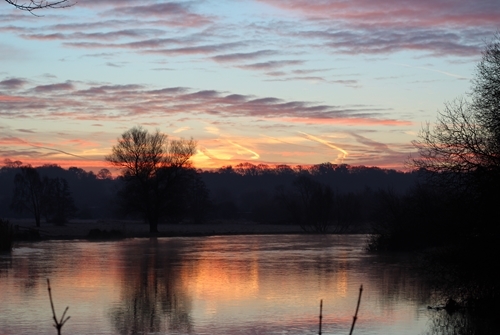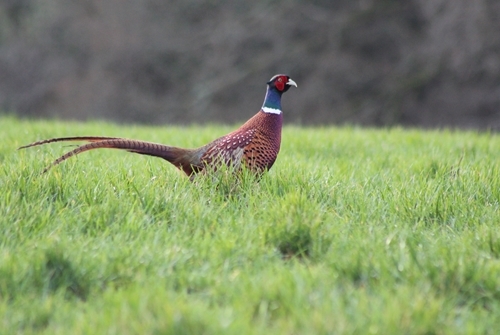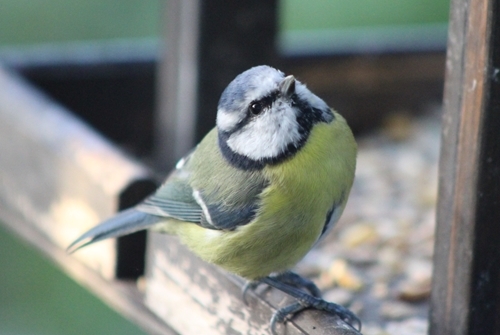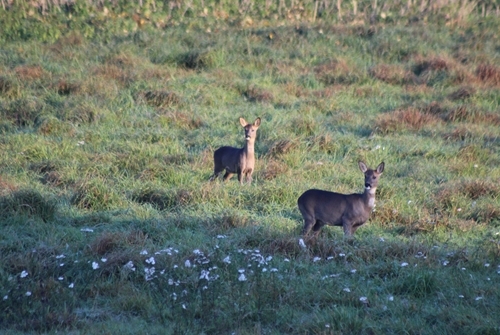Written by Samantha Skinner, GIS Placement Student
As a placement student at the Game and Wildlife Conservation Trust HQ in Fordingbridge, I have the New Forest as my back garden, Stonehenge is just over the hill and the river Avon is literally on my doorstep. It’s amazing to have so many interesting places right at my fingertips and I love being able to spend my weekends exploring, sightseeing and discovering, but it’s only a part of what makes my placement year exciting. What makes a year at the GWCT an engaging and wholesome experience is the day-to-day.

I usually wake up at around 8am, sometimes a bit earlier, and spend the morning getting ready for work with the news or some music on in the background. It’s winter, so the sun rises late, and often, quite spectacularly. I’m up early enough today, so I’ll take my coffee outside to enjoy the kaleidoscope sky and watch the birds. Our garden’s frequent visitors are blue tits and great tits but often dunnocks and occasionally a coal tit will stop by. Fluffy, round long-tailed tits flit nonchalantly between the twigs and branches of the trees beyond the garden, I haven’t figured out how to coax them down yet. And of course, there are the robins, a teasy bunch but they can’t say no to the sunflower hearts!
There is also a woodpecker who frequently climbs the sweet chestnut tree in front of the house, but I haven’t had a good enough look yet to tell whether it is a greater spotted or a lesser spotted... I’ll let you know! Sometimes wildlife dramas unfold on the rearing field, a barn owl has taken roost in the owl box and can often be seen hunting for rodents in the grass. Occasionally other birds take an interest, I’ve seen sparrowhawks, buzzards, magpies and jays ‘join’ the hunt, looking to steal an easy meal. Oftentimes roe deer may be grazing passively in the field, or a cock pheasant will strut down the drive; but not this morning, just tits and robins, and a glorious sunrise.

After dragging myself away from the birds and a bite to eat with my housemates, it’s time for work. The trek is a stifling 50 yards – I wish I’d brought my car – and the day begins with a quick check of our e-mails, a read of the daily newsround, and the usual good-morning chit chat. Working in an office is actually pretty great. I love my colleagues and the work is really interesting; unlike the ongoing endeavour to complete uni work, getting stuff done is easy at least from a motivational point of view. Working with ArcGIS (a mapping software) does have its challenges, as do the projects we work on, but that’s all part of what makes it interesting.
This morning however, I am working on finishing up some map documents, designing, colouring and exporting maps as PDF files for presentation to a large client. Very therapeutic and very satisfying. What is that they say about geography being colouring in? Before I know it, it’s 13:00. Lunch time is going to be busy. Sometimes if I don’t have a lot to do, I’ll enjoy the time and socialise with my housemates, take my camera out for a bird photoshoot, or squeeze in an episode of The Office but tonight there’s a hare count, so I must eat lunch, prepare my tea and find some warm clothes!

The afternoon passes much like the morning – productively – with the occasional off-topic discussion about other projects, dogs, life in general. I’m writing documentation for the project we are finishing up, not as therapeutic as colouring maps but it must be done. The tasks we are set in the office can vary from mapping and writing up projects to entering and checking data, and various administrative tasks. However, In the spring I’ll be trading my computer screen for a clip board and joining the wetlands team studying breeding waders in the field! As an environmental science student, I find the mix of geography-based projects and ecology projects (and those everywhere in-between) a refreshing way to practice and enhance the skills I have gained through my degree, as well as adding a few more to my repertoire.
17:30. Home Time! I reheat some food and start piling on the layers. One of the perks of a placement at the Trust is an ample supply of opportunities to get stuck in and experience other projects. Tonight, some of us are joining a hare count! After spending a good part of half an hour looking for my binoculars, I’m ready to go, and we pile into the car bound for East Hampshire. Hare counts consist of shining bright lamps from the open windows of a vehicle in the dark, looking for eyeshine (a technique called lamping!).

Sometimes the colour of the eyeshine is indicative of the species you are looking at; blue/green for a fox, white for a woodcock, yellowish-white for a rabbit or hare, but most of the time, you can get a good look at the creature in the lamplight or through a pair of binoculars. We see plenty of hares among other fascinating nightlife - there is a buzz of excitement when a long-eared owl is seen swooping over the car, and then a woodcock erupts from the grass just feet from the windscreen! Little owls, tawny owls and barn owls also make an appearance, along with startled skylarks, roe deer and the odd fox.
After a successful evening of field work, it’s time for bed.
A year at the GWCT is an opportunity to spend a year doing what you love; a year of not just exploring, sight-seeing, and discovering, but of learning, mapping, fieldworking, socialising, bird watching, photographing, tea making goodness.
I can’t think of a better way to be spending my placement year.